The adoption of workforce management (WFM) systems is on the rise, driving value across every layer of an organization – from enhancing customer experiences to improving agent satisfaction, reducing costs, and supporting smarter, data-led decisions.
But where is this technology having the biggest impact?
We asked the experts for their best, real-life use cases of WFM to find out…
Ensuring Voice Queues Aren’t Overloaded When Chat Volumes Spike

WFM tools can dynamically adjust staffing as volume shifts between channels – ensuring voice queues aren’t overloaded when chat volumes spike.
Intraday management and real-time adherence monitoring allow supervisors to react quickly to unexpected changes, reallocating resources where needed.
For agents, automated scheduling, shift swaps, and performance tracking provide more flexibility and transparency – boosting engagement and reducing burnout.
Ultimately, WFM helps balance efficiency with service quality, balancing staffing with customer expectations and business goals. In a true omnichannel environment, it’s the backbone of operational agility and a more human, responsive customer experience.
Contributed by: Tara Aldridge, Strategic Services Director, Vonage
Making Sure the Right Skills Are Available When Customers Need Them Most

By combining WFM data with other contact centre data analytics, businesses can level up their resourcing even further – not just filling shifts, but ensuring the right skills are available at the times customers need them most.
WFM can also be integrated with HR, quality assurance and coaching platforms to cut admin overhead and further enable smarter scheduling – like aligning staff coaching sessions with availability.
Contributed by: Ben Willmott, Principal Solution Consultant, Route 101
Turning Reactive Headcount Planning Into Proactive, Data-Led Scenario Modelling

The biggest return on WFM systems is in the implementation of the strategy, realizing the budget and driving effective decision-making, which supports both the colleague and customer, including:
- Workforce Intelligence & Strategic Reporting – Workforce management creates insight which improve intelligence and decision-making. WFM becomes a key contributor to workforce analytics and continuous improvement.
- Proactive Capacity & Scenario Planning – Workforce management’s most strategic value lies in turning reactive headcount planning into proactive, data-led scenario modelling.
- Controlled Agent Self-Service – Allowing self-managed schedules, including swaps, annual leave, coaching, development, overtime, etc. All within rules that preserve priorities. This balance between flexibility and control reduces admin for planners, increases engagement, and enhances employee experience.
- Real-Time Decision Making – Real-time visibility tools enable operational teams to monitor the intraday load and proactively act to balance commercial, customer and colleagues, joining up the strategic intent with on-the-day execution.
Having a data journey from strategy, through to budget plans, through to on-the-day management supports a joined-up culture which can keep learning and driving improvements.
Contributed by: Phil Anderson, CEO, The Forum
Using Real-Time Adherence as a “Carrot” to Motivate Agents

Assuming your basics are in place, use real-time adherence as a carrot to motivate agents. It may be viewed by some as a surveillance tool – after all, if agents don’t stick to schedules, the plan goes out of the window – but can absolutely be used to build trust, and help maximize service delivery.
Next, get bold with scenario modelling! What if conversational AI handled that call type? What if you cut 60 seconds off AHT by replacing a legacy product with a low-code solution?
WFM lets you model service redesigns that have real-world impact, so I’d encourage you to use it to challenge assumptions and reshape how you work.
Contributed by: Lewis Gallagher, Senior Solutions Consultant, Netcall
Supporting Agents With Ultra-Flexible Working – Remotely and Across Multiple Locations

WFM is enabling granular flexibility, allowing organizations to tap into a wider talent pool, improve service levels, and reduce costs while enhancing work–life balance for agents.
While WFM has always played a critical role in physical contact centres, its value has grown exponentially in today’s distributed, remote-first environments.
In physical centres, supervisors could support staff in real time, but with agents working remotely or across multiple locations, WFM becomes the central nervous system of operations.
One of the most underrated use cases is the ability to offer ultra-flexible, partial shifts based on traffic predictions and real-time influxes in demand.
WFM tools now enable contact centres to respond dynamically to demand, recruiting from an inactive workforce and scheduling shorter 30-minute or one-hour-long shifts during peak loads.
For example, a parent might be able to take an hour-long shift after the school run, a scenario that would have been previously unthinkable under legacy scheduling models.
Contributed by: Martin Taylor, Co-Founder and Deputy CEO, Content Guru
Rising to the Challenge of Managing Unplanned Absences

Intraday management is one of the most underrated yet valuable WFM tools for maintaining agility under pressure.
By monitoring real-time performance, teams can react quickly to fluctuations in demand and adapt on the fly by adjusting staffing levels, rebalancing queues, reallocating breaks, or offering targeted support. This is especially powerful in hybrid or multiskill environments where change is constant.
According to Peopleware’s 2025 Benchmark Report, the most common challenge for organizations is unplanned absences, followed by poor adherence.
High-performing teams dedicate over 17 hours per week to intraday management, and the number of teams achieving 90%+ adherence has doubled since 2020.
However, the report also revealed that 38% of organizations still operate reactively to real-time changes, risking service levels and employee workload balance.
These insights make it clear that more WFM leaders need to make intraday management a top priority, and the impact that the right tools can make.
Contributed by: Zainab Ahmed, Marketing Manager, Peopleware
WFM Systems Have Become Far More Than Just Scheduling Tools
As contact centres evolve into complex, omnichannel environments, workforce management (WFM) systems have become far more than just scheduling tools – they’re now strategic enablers of agility, efficiency, and employee engagement.
From dynamically balancing workloads across voice and digital channels to empowering remote teams with flexible shift options, WFM plays a pivotal role in both daily operations and long-term transformation.
How Is Your WFM System Changing Your Operation for the Better?
Click here to join our NEW Readers Panel to share your experiences and feature in future Call Centre Helper articles.
For more great insights and advice from our panel of experts, read these articles next:
- 10 New Ways Tech Is Helping Agents Right Now
- Bad Habits That Kill Resource Planning
- How to Maintain High Quality on Self-Service Channels
Author: Megan Jones
Reviewed by: Rachael Trickey
Published On: 19th Aug 2025 - Last modified: 14th Oct 2025
Read more about - Technology, Absenteeism, Ben Willmott, Content Guru, Lewis Gallagher, Martin Taylor, Netcall, Peopleware, Phil Anderson, Queues, Real-Time Management, Route 101, Tara Aldridge, The Forum, Top Story, Vonage, Workforce Management (WFM), Zainab Ahmed








































